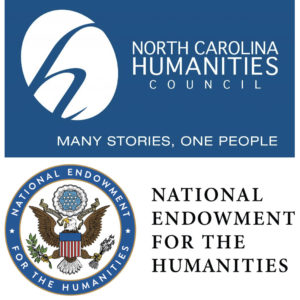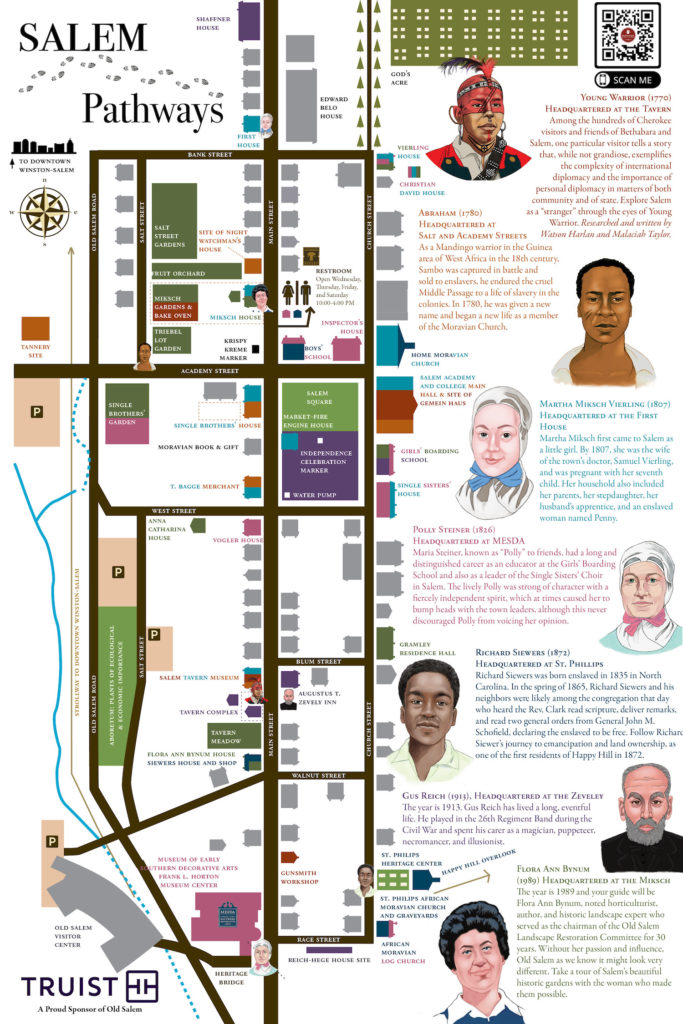Salem Pathways

CLICK HERE IF YOU ARE IN THE DISTRICT AND READY TO PLAY!
Funded by NC CARES: Humanities Relief Grant

FOLLOW THE PATHS OF THOSE BEFORE US… Experience the personal lives, achievements, and challenges of real-life individuals who lived in or visited Salem from 1770 to 1989. These historical figures will take you on a tour of Salem’s historic district through their eyes. It’s up to you to choose who to follow and where you go.
WHAT TO BRING…
- Your mobile device (smartphone, tablet, or other connected device)
- Headphones for each device that will be following pathways
- Comfortable walking shoes
- A mask and hand sanitizer
- A friend
- Snacks
- A picnic blanket
- A desire to explore

HOW IT WORKS: Head to Old Salem’s Historic District and choose one of the headquarter locations (HQs) on this map (where you see a portrait). A wooden box with paper maps will be located at each locations. The map will help you find different buildings, features, and other locations within the district that could potentially be on any of the Salem Pathways tours.
Once you find your character’s HQ, open the box and pull out a map. Use your phone’s camera to scan the QR code, or follow this link. After providing some information, you will be directed to a page where you get to select your favorite person to go on an adventure with in the district.
Along the way, you will listen to music and sounds from that person’s life, look at videos and images related to their personal experiences, and most importantly, hear their stories, stand in the very spots, look at the same buildings and landscapes, and walk the same paths they did while they were at Salem.
**Please note, Salem Pathways is a completely fictional interpretation of the history of these historical figures. To learn more about what sources we used to craft these narrative stories, click “Learn More” at the end of each adventure.**
BONUS RECOMMENDATION TO SHARE YOUR EXPERIENCE:

- This app is NOT required to play Salem Pathways. Salem Pathways is not an app, it is a choose-your-adventure template using your phone’s internet browser. However, if you would like to track your fitness and record your experience, Relive is a fun app to use while experiencing Pathways
- Download the Relive App from the Apple App Store or Google Playstore
- Turn on the Relive App before starting your adventure
- Take pictures and screenshots of Pathways along the way
- See how much exercise you got and relive all the fun you had at the end of your journey!

Young Warrior (1770)
Headquartered at the Tavern
This story was researched and written by Cherokee Advisory Committee advisors Watson Harlan (CNO) and Malaciah Taylor (EBCI).
Cherokee have been in contact with the settlers of Salem and Bethabara about as long as there have been settlers in these regions. The first recorded visit of a Cherokee to the Moravians was in 1752. Many Cherokee attended church services while in the town as a show of respect to the people there. Although they attended the services, the first official conversion of a Cherokee to the Moravian faith wouldn’t occur until 1809, after a mission was constructed in 1805 in the Nation. Among the hundreds of Cherokee visitors and friends of the two towns, one particular visitor tells a story that, while not grandiose, exemplifies the complexity of international diplomacy and the importance of personal diplomacy in matters of both community and of state. Explore Salem as a “stranger” through the eyes of Young Warrior.

Abraham (1780)
Headquartered at Salt and Academy Streets
As a Mandingo warrior in the Guinea area of West Africa in the 18th century, Abraham was caught in the turmoil of the times. Captured in battle and sold to enslavers, leaving behind a family and many children in West Africa, he endured the cruel Middle Passage to a life of slavery in the colonies. After his arrival on a French island in the West Indies, he was taken to Virginia. In 1771 his enslaver brought “Sambo,” as he was called, and another native African to Wachovia to sell. Torn away from the life he knew, he found himself isolated in a strange land surrounded by people who didn’t speak his language. In 1780, he was given a new name and began a new life as a member of the Moravian Church. Follow his path as one of the first enslaved Moravian brethren in Salem.

Martha Miksch Vierling (1807)
Headquartered at the First House
Martha Miksch first came to Salem as a little girl, when her parents Matthew and Henrietta Miksch, moved the family into a small house on Main Street. As a child in a tightly controlled Moravian congregation town, she grew up in a place where major decisions were made by church leaders and residents (children and adults alike) were expected to follow the church’s rules. Everything from where you lived, how you made a living, and even who you married was subject to church approval. While some townspeople chaffed under this strict regimen, Martha seems to have thrived. Humble, hardworking, intelligent, and devout, Martha navigated her world with a quiet dignity and grace. By 1807, she was the wife of the town’s doctor, Samuel Benjamin Vierling, and was pregnant with her seventh child. Her household also included her parents, her stepdaughter, who was visiting from Pennsylvania, her husband’s apprentice, and, by the end of the year, an enslaved woman named Penny. Join Martha as she goes about another busy day in Salem.

Polly Steiner (1826)
Headquartered at MESDA
Maria Steiner, known as “Polly” to friends, had a long and distinguished career as an educator at the Girls’ Boarding School and also as a leader of the Single Sisters’ Choir in Salem. Her love of learning, highly inquisitive mind, and patient and kind disposition made her an excellent teacher, leader, and friend. The lively Polly was strong of character with a fiercely independent spirit, which at times caused her to bump heads with the town leaders, although this never discouraged Polly from voicing her opinion and seeking her own path. Come along with Polly as she navigates the streets of Salem in 1826.

Richard Siewers (1872)
Headquartered at St. Phillips
Richard Siewers was born enslaved in 1835 in North Carolina. By the spring of 1865 the Civil War was ending. On April 10, Union General William J. Palmer stayed overnight in Salem. In the coming weeks, Confederates from General Robert E. Lee’s surrendered army passed through Salem daily. Certainly, news was circulating about the end of the war and hopes for freedom. At the Sunday service in the African Church on May 21, 1865 a large crowd gathered from Salem and the area. According to the “Negro Church Diary” for May 21: “The church was crowded with colored people, and a few whites, it having become known that the Rev. Mr. Clark, chaplain of the 10th Regt. Ohio Cavalry, would speak.” Richard Siewers and his neighbors were likely among the congregation that day who heard the Rev. Clark read scripture, deliver remarks, and read two general orders from General John M. Schofield, declaring the enslaved to be free. Follow Richard Siewer’s journey to emancipation and land ownership, as one of the first residents of Happy Hill in 1872.

Gus Reich (1913)
Headquartered at the Zeveley Inn
The year is 1913. Winston and Salem have merged to become the brand new city of Winston-Salem. By this time, Gus Reich has lived a long, eventful life. Drop in on Gus, at the age of 80, as he reminisces about his youth, trading war stories from his experience with the 26th Regiment Band during the Civil War, and sharing the tale of his unorthodox career as a magician, puppeteer, necromancer, and illusionist…but be careful, he has a few tricks up his sleeve.

Flora Ann Bynum (1989)
Headquartered at the Miksch Garden
The year is 1989 and your guide will be Flora Ann Bynum, noted horticulturist, author, and historic landscape expert who served as the chairman of the Old Salem Landscape Restoration Committee for 30 years. According to her friends, “Flora Ann was always available to advise the humblest of individuals about their home gardens. Women and men often telephoned, wrote, knocked at her door or entered her garden seeking advice or inquiring about the name of a flower…Sharing the answer was for Flora Ann an act of graciousness and a small step in her mission to save the Southern landscape.” Without her passion and influence, Old Salem as we know it, might look very different. Take a tour of Salem’s beautiful historic gardens, with the woman who helped make them possible. – Magnolia Bulletin of the Southern Garden History Society, 2006

THE VISION:
Old Salem and MESDA have taken advantage of the temporary closure brought on by COVID-19 by allocating additional time and resources towards their Study South initiative, allowing for extensive study of the historical records and material culture of the American South. Salem Pathways is a direct result of this additional research focus. Each pathway will be filled with historical narratives, artifacts, and other material culture related to each person and time period.
Salem Pathways observes how all of our lives are interconnected through the spaces we share, even across time. Even though each of these people are vastly different and come from different time periods, the physical space of Salem acts as a confluence to bring them, and all of us, together.
